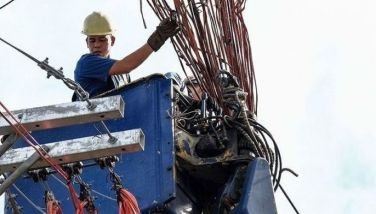Peso hits new 14-month low of 53.47 to dollar
October 22, 2002 | 12:00am
The peso hit a new 14-month low of 53.470 against the dollar in early morning trade yesterday in the wake of the deadly bombings in Mindanao and Manila.
The level was the lowest since the peso hit 53.610 to the dollar on Aug. 3, 2001.
At the end of trading, however, the peso managed to recover some lost ground to settle at 53.205 for an 8.50-centavo gain from Friday’s close of 53.290 to the dollar.
Bangko Sentral ng Pilipinas (BSP) Governor Rafael Buenaventura said the peso’s weakness was "temporary" and that monetary officials were closely watching the market.
Traders said that the BSP was in the market for as much as $25 million but Buenaventura insisted that yesterday’s play was purely market-driven.
"We did not intervene," Buenaventura said amid speculations that the BSP actually channeled its play through Chase Manhattan and Standard Chartered Bank.
The BSP chief said the peso merely tracked other currencies in the region and although there was initial volatility during the morning session, nerves calmed down towards the end of the day.
"The initial volatility calmed down because no other untoward incident happened," Buenaventura pointed out. "The market is still jittery but that is to be expected," he added.
At the Philippine Dealing System (PDS), the peso opened at 53.380 to the dollar, tumbling to as low as 53.470 before recovering to as high as 53.190 and finally closing at 53.205 to $1. Total volume traded amounted to $122 million.
The peso joined other regional currencies in their recovery, led by the Indonesian rupiah which went up from R9,250 last Friday to R9,200 yesterday. The Singapore dollar was also up as well as the Korean won.
BSP Deputy Governor Amando Tetangco Jr, on the other hand, said the peso will appreciate before the year ends on the back of record-high dollar remittances from overseas Filipino workers (OFWs).
Yesterday’s correction did not surprise the BSP which said over the weekend that despite the fact that this year has been worse than last year for most currencies in the region, the peso has so far been more stable than it had been in 2001.
The BSP expects the peso to correct somewhat this week, as long as the market will not be stirred again by extraordinary events that create uncertainty and spur artificially high demand for dollars.
BSP data showed the peso actually achieved remarkable stability this year, with its average volatility charted at 4.8 percent during the first seven months of the year compared with last year’s volatility level of 17.6 percent.
From July to September, the BSP said the average volatility was recorded at 5.1 percent this year compared to last year’s 6.5 percent.
"These figures suggest that the fluctuations in the peso-dollar exchange rate have relatively smoothened out this year," Buenaventura said. "We’ve seen worse in 2001," he added.
The level was the lowest since the peso hit 53.610 to the dollar on Aug. 3, 2001.
At the end of trading, however, the peso managed to recover some lost ground to settle at 53.205 for an 8.50-centavo gain from Friday’s close of 53.290 to the dollar.
Bangko Sentral ng Pilipinas (BSP) Governor Rafael Buenaventura said the peso’s weakness was "temporary" and that monetary officials were closely watching the market.
Traders said that the BSP was in the market for as much as $25 million but Buenaventura insisted that yesterday’s play was purely market-driven.
"We did not intervene," Buenaventura said amid speculations that the BSP actually channeled its play through Chase Manhattan and Standard Chartered Bank.
The BSP chief said the peso merely tracked other currencies in the region and although there was initial volatility during the morning session, nerves calmed down towards the end of the day.
"The initial volatility calmed down because no other untoward incident happened," Buenaventura pointed out. "The market is still jittery but that is to be expected," he added.
At the Philippine Dealing System (PDS), the peso opened at 53.380 to the dollar, tumbling to as low as 53.470 before recovering to as high as 53.190 and finally closing at 53.205 to $1. Total volume traded amounted to $122 million.
The peso joined other regional currencies in their recovery, led by the Indonesian rupiah which went up from R9,250 last Friday to R9,200 yesterday. The Singapore dollar was also up as well as the Korean won.
BSP Deputy Governor Amando Tetangco Jr, on the other hand, said the peso will appreciate before the year ends on the back of record-high dollar remittances from overseas Filipino workers (OFWs).
Yesterday’s correction did not surprise the BSP which said over the weekend that despite the fact that this year has been worse than last year for most currencies in the region, the peso has so far been more stable than it had been in 2001.
The BSP expects the peso to correct somewhat this week, as long as the market will not be stirred again by extraordinary events that create uncertainty and spur artificially high demand for dollars.
BSP data showed the peso actually achieved remarkable stability this year, with its average volatility charted at 4.8 percent during the first seven months of the year compared with last year’s volatility level of 17.6 percent.
From July to September, the BSP said the average volatility was recorded at 5.1 percent this year compared to last year’s 6.5 percent.
"These figures suggest that the fluctuations in the peso-dollar exchange rate have relatively smoothened out this year," Buenaventura said. "We’ve seen worse in 2001," he added.
BrandSpace Articles
<
>
- Latest
- Trending
Trending
Latest
Trending
Latest
Recommended






























